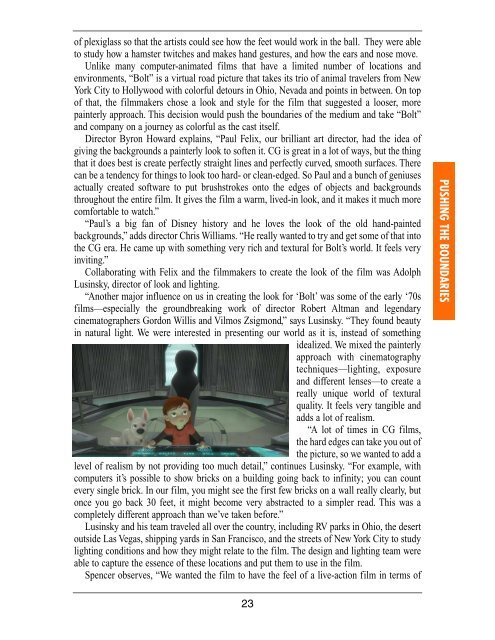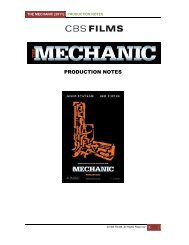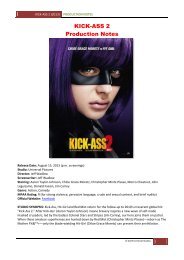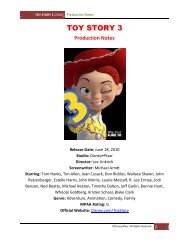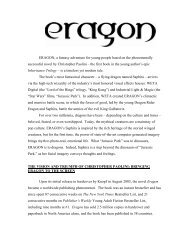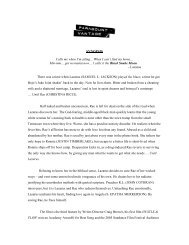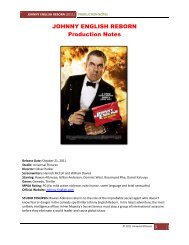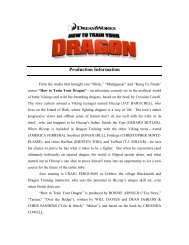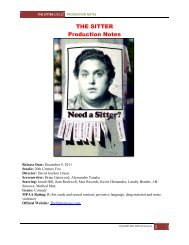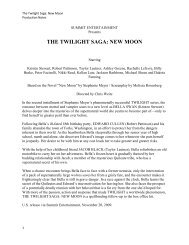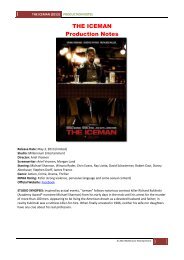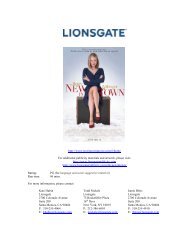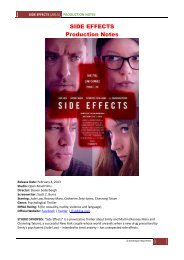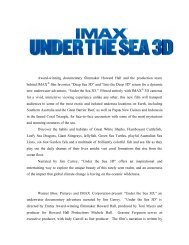You also want an ePaper? Increase the reach of your titles
YUMPU automatically turns print PDFs into web optimized ePapers that Google loves.
of plexiglass so that the artists could see how the feet would work in the ball. They were able<br />
to study how a hamster twitches and makes hand gestures, and how the ears and nose move.<br />
Unlike many computer-animated films that have a limited number of locations and<br />
environments, “Bolt” is a virtual road picture that takes its trio of animal travelers from New<br />
York City to Hollywood with colorful detours in Ohio, Nevada and points in between. On top<br />
of that, the filmmakers chose a look and style for the film that suggested a looser, more<br />
painterly approach. This decision would push the boundaries of the medium and take “Bolt”<br />
and company on a journey as colorful as the cast itself.<br />
Director Byron Howard explains, “Paul Felix, our brilliant art director, had the idea of<br />
giving the backgrounds a painterly look to soften it. CG is great in a lot of ways, but the thing<br />
that it does best is create perfectly straight lines and perfectly curved, smooth surfaces. There<br />
can be a tendency for things to look too hard- or clean-edged. So Paul and a bunch of geniuses<br />
actually created software to put brushstrokes onto the edges of objects and backgrounds<br />
throughout the entire film. It gives the film a warm, lived-in look, and it makes it much more<br />
comfortable to watch.”<br />
“Paul’s a big fan of Disney history and he loves the look of the old hand-painted<br />
backgrounds,” adds director Chris Williams. “He really wanted to try and get some of that into<br />
the CG era. He came up with something very rich and textural for Bolt’s world. It feels very<br />
inviting.”<br />
Collaborating with Felix and the filmmakers to create the look of the film was Adolph<br />
Lusinsky, director of look and lighting.<br />
“Another major influence on us in creating the look for ‘Bolt’ was some of the early ‘70s<br />
films—especially the groundbreaking work of director Robert Altman and legendary<br />
cinematographers Gordon Willis and Vilmos Zsigmond,” says Lusinsky. “They found beauty<br />
in natural light. We were interested in presenting our world as it is, instead of something<br />
idealized. We mixed the painterly<br />
approach with cinematography<br />
techniques—lighting, exposure<br />
and different lenses—to create a<br />
really unique world of textural<br />
quality. It feels very tangible and<br />
adds a lot of realism.<br />
“A lot of times in CG films,<br />
the hard edges can take you out of<br />
the picture, so we wanted to add a<br />
level of realism by not providing too much detail,” continues Lusinsky. “For example, with<br />
computers it’s possible to show bricks on a building going back to infinity; you can count<br />
every single brick. In our film, you might see the first few bricks on a wall really clearly, but<br />
once you go back 30 feet, it might become very abstracted to a simpler read. This was a<br />
completely different approach than we’ve taken before.”<br />
Lusinsky and his team traveled all over the country, including RV parks in Ohio, the desert<br />
outside Las Vegas, shipping yards in San Francisco, and the streets of New York City to study<br />
lighting conditions and how they might relate to the film. The design and lighting team were<br />
able to capture the essence of these locations and put them to use in the film.<br />
Spencer observes, “We wanted the film to have the feel of a live-action film in terms of<br />
PUSHING THE BOUNDARIES<br />
23


